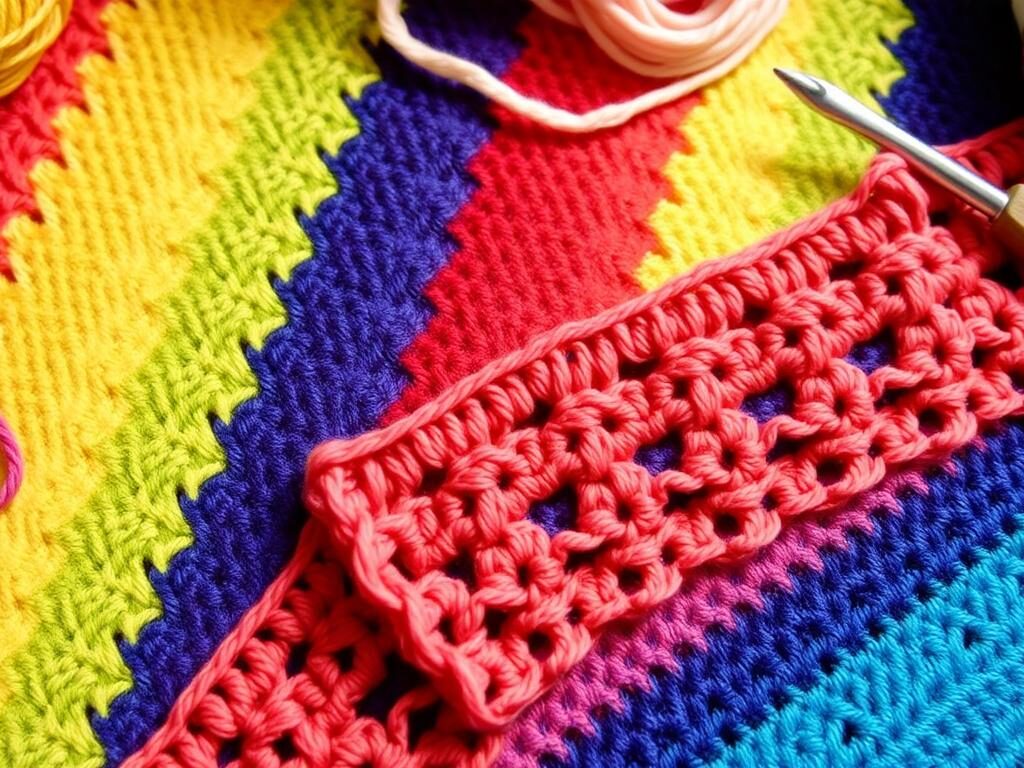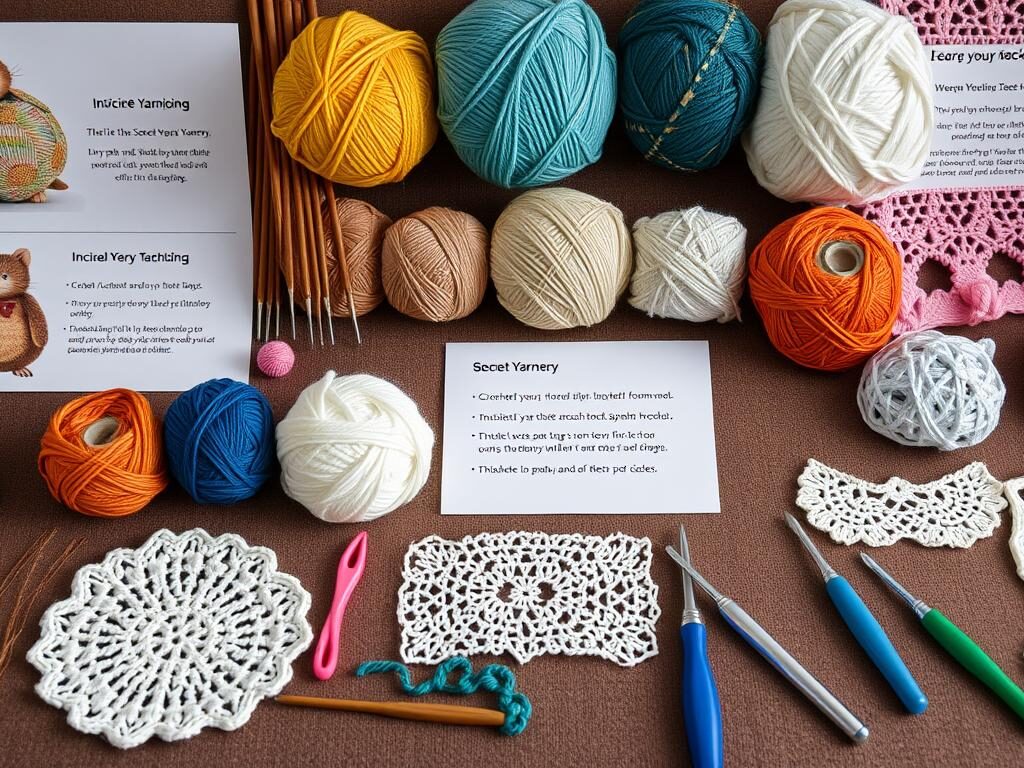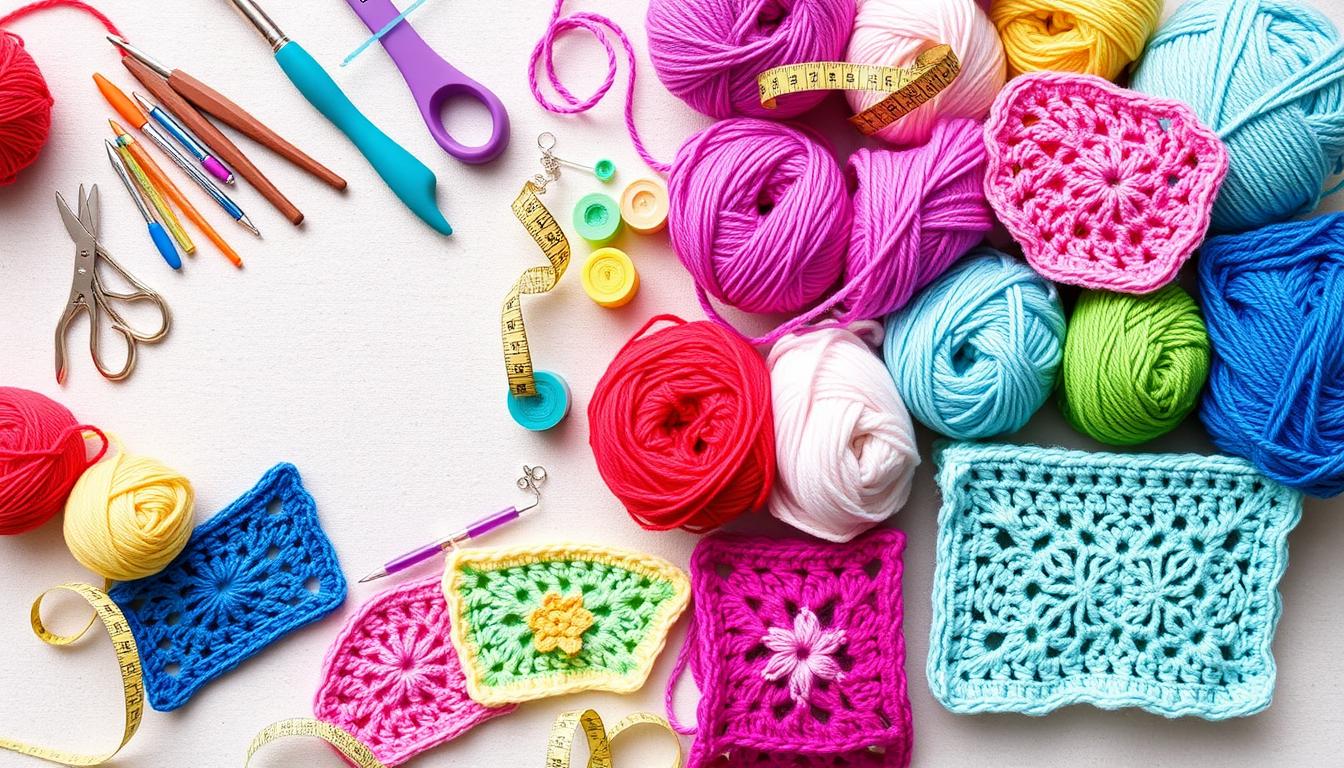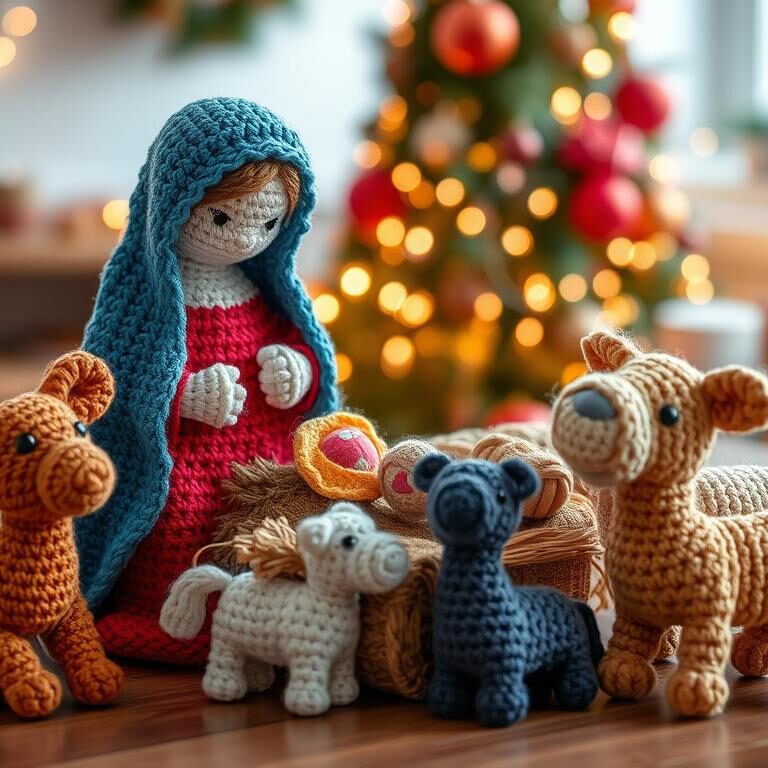10 Clever Crochet Hacks to Boost Your Skills
As a dedicated crafter, I’ve always been amazed at how a single hook and a skein of yarn can create intricate beauty. Yet, as with any skill, there’s always room to grow. That’s why I’m thrilled to share my top crochet hacks—time-tested tips and tricks poised to elevate your crafting game to new heights. Whether you’re weaving a winter scarf or coaxing a blanket square by square into being, these crochet life hacks are essential for anyone looking to boost their crochet prowess.
Delving into these crochet skill boosters, it’s clear that genius sometimes lies in simplicity. Take the foundation single crochet (FSC) stitch, for example—an underappreciated starting point for projects that demand stability and elegance. Or consider the transformative power of techniques such as the magic circle, pivotal for projects that call for a flawless commencement. If you’re embarking on a journey into the intricate realms of crochet, these hacks aren’t just nifty—they’re necessary.
Key Takeaways
- Foundation crochet such as the FSC stitch is a cornerstone for starting strong.
- The magic circle requires patience but rewards with impeccable beginnings.
- Essentials like the single crochet are simple yet pivotal for beginners to master.
- Reverse single crochet, or Crab Stitch, adds polished edges to any piece.
- Unlocking the potential of the HDC’s third loop can revolutionize textures.
- Invisible joining methods like the Russian Join enhance project aesthetics.
- Understanding color changes and weaving in ends ensures a meticulous finish.
Unlocking the Potential of Foundation Crochet
Foundation crochet is a game-changer for crocheters. It saves time, cuts down on yarn waste, and skips the hassle of traditional chaining. This change makes projects faster and the foundation more flexible and stretchy, perfect for snug fits.
The chainless foundation technique is simple and stable. It’s a shortcut that saves time and improves the fabric’s texture. Foundation single crochet (FSC) is especially good for a stable, stretchy base without the usual chain wobble.
Foundation stitches offer adjustable lengths and easy adjustments during projects. This is a big win for crochet efficiency. Adding these techniques to your skills makes your fabric’s foundation more adaptable.
Chainless Foundation Technique
The chainless foundation technique has changed my crochet game. It makes starts more consistent and flexible. You build stitches directly on the first row, combining two steps into one. It’s great for clean, sturdy starts without the bulk of traditional chains.
Foundation Single Crochet for Stability
Foundation single crochet (FSC) is top-notch for starting rows. It’s my favorite for designs needing a firm yet elastic edge, like hats and socks. This stitch gives a strong edge and a nice look, essential for quality crochet finishes.
Improving crochet techniques like the chainless foundation and FSC has made my projects better. These innovations and shortcuts help others start their crochet journey without the usual hurdles. They open up creative possibilities.
Using these foundation stitches in projects like afghans and sweaters makes the process easier. It boosts the project’s function and looks. This shows how valuable efficient crochet hacks are in everyday practice.
Mastering the Magic Circle for Flawless Projects
As I explore crochet, learning the Magic Circle has been a game-changer. It’s key for tight centers in Amigurumi, hats, and granny squares. At first, it seems tough, but it pays off with perfect results.
Using a 3.5mm Rose Gold Odyssey hook and #4 worsted weight Red Heart Super Saver yarn has been great. The yarn’s thickness makes each stitch clear, helping beginners grasp the Magic Circle.
- Start with a 5-6″ tail for securing and weaving in ends later.
- Light-colored yarns like off-white or light pink help beginners see each stitch.
- Using a 3.5mm hook makes the learning process easier with its big loop.
A step-by-step video tutorial has been crucial for me. It shows the magic ring step by step, making it easier to learn. It’s perfect for those who learn better by watching.
Regular practice of the Magic Circle technique will not only enhance your skill but significantly speed up your project initiation time. It’s all about muscle memory.
For US notation users, abbreviations like sc (single crochet), inc (increase), and st (stitch) are common. They help keep everyone on the same page. Left-handed crafters can find special resources to help them too.
Learning the Magic Circle is worth it. It makes starting circular crochet projects easy and looks professional. Adding it to your skills will open up more project options. Take on this challenge and soon, you’ll do it with confidence.
The Art of Front and Back Loop Crochet
Exploring front and back loop crochet can make your crochet pieces better. It moves your skills from simple to complex. This skill is key for any serious crocheter, opening up new ways to texture and shape your work. Let’s see how these methods can boost your crochet skills and add to your collection of tips and tricks.
Creating Texture with Front Loop Crochet
Front loop crochet is great for adding raised lines and ridges. It’s perfect for making ribbed patterns or highlighting design elements. By using the front loop only, you create a subtle ridge. This is great for projects like hats or bags where you want a tactile feel.
Enhancing Stretch with Back Loop Crochet
Working with the back loop makes the fabric stretchy. This is perfect for clothes like sweaters and socks that need to stretch. The stretch is also good for edges and borders that need to fit well.
| Technique | Property | Use-case |
|---|---|---|
| Both Loops | Thick and Firm | Amigurumi, maintaining shape |
| Front Loop Only | Textured and Stretchy | Ribbing patterns, clothing |
| Back Loop Only | Fluid and Elastic | Sweaters, socks with elasticity |
Mastering front and back loop crochet opens up new possibilities. It makes your crochet projects more functional and creative. Whether you’re aiming for durability, texture, or stretch, knowing when to use these techniques will improve your work. Remember, the best way to get better at crochet is to keep trying and practicing. Use these tips to make your next project stand out!
Reverse Single Crochet: A Twist on Traditional Edges
As a crochet lover, I always look for new techniques. The reverse single crochet, or Crab Stitch, is a great find. It makes edges look good and saves time.

This stitch works well with simple projects like sun hats and sweater necklines. It’s easy to do and adds a textured look. This is perfect for things like C2C graphgans.
There are many crochet edges to choose from. You can go for something delicate like the tulip blanket trim or something more bold like the camel stitch border. Each one has its own charm and purpose.
For a fancy touch, try a triple picot border or coronet lace trim. Or, if you’re new to crochet, the clusters and puffs dot border is a great choice. It’s easy and adds a lot of style to simple projects.
The reverse single crochet is a top pick for its mix of function and style. It’s easy to use, making it great for both new and experienced crocheters. It helps make edges look good and last long.
Using the reverse single crochet on a baby blanket or a spring towel adds a special touch. It makes your projects look professional and saves time. It’s a win-win for your crafting.
Discovering the 3rd Loop in Half-Double Crochet
Exploring half-double crochet revealed crochet hacks that improve project texture and look. These hacks don’t need extra tools. They’re great for making items look like they’re knitted.
Half-double crochet has a secret: the third loop. This loop is hidden in simpler stitches like single crochet. It opens up new possibilities for crochet hacks, making it a key part of our craft.
Using the 3rd loop is simple. I use Red Heart Soft “Off-White” yarn with a 5mm Furls Rose Gold hook. This combo ensures smooth, even stitches. It’s perfect for showing off the stitch’s beauty. You can adjust the hook size to fit different projects, from tight amigurumi to loose garments.
| Technique | Details |
|---|---|
| Yarn & Hook | Red Heart Soft “Off-White”, 5mm Furls Rose Gold hook |
| Starting Chains for Ribbing | Start with 11 chains |
| HDC Stitches per Row | 10 in each row for the ribbed band |
| Texture Technique | Crocheting into the 3rd loop |
| Practice Tip | Regular practice mastering the 3rd loop |
The third loop in half double crochet changes the look of your work. It adds depth and structure. This method balances stability and decoration, perfect for edges or patterns in sweaters or beanies.
My journey into crochet efficiency hacks shows the importance of knowing each loop’s role. The back third loop is great for firm shapes. The front third loop is perfect for ribbed designs that look like they’re knitted.
This new way of crocheting encourages me to try new things. It lets me push the limits of what’s possible with just a hook and yarn.
I suggest trying this technique out. Start with a simple project like a hat or scarf. It’s a fun journey that makes our crafting more interesting, one stitch at a time!
Crochet Hacks: Invisible Yarn Joining Techniques
As a seasoned crocheter, I know how hard it can be to keep projects looking smooth. Invisible yarn joining techniques, like the Russian Join, are key. They make your projects look better and save you time.
The Russian Join hides yarn ends, making your work look flawless. It’s great for adding new yarn or changing colors. It gives your projects a strong and almost invisible finish.
Many crocheters struggle with visible seams, especially when finishing rounds. But, techniques like the Mock Invisible Join have changed that. They make projects look perfect, especially when you need a clean finish.

Using invisible joins makes your projects look better and saves time. Studies show they can save a lot of time compared to old methods. This makes them a must-have for crocheters who want to improve their craft.
But, not every project is right for every invisible join. Some projects need special techniques to look and feel right.
Perfecting the Russian Join
I encourage all crocheters to try these joining techniques. They can turn your projects into true works of art. Learning them is rewarding, improving both your projects and your time management.
| Technique | Project Suitability | Visibility of Join | Time Saved |
|---|---|---|---|
| Russian Join | Multi-color projects | Low | High |
| Mock Invisible Join | Continuous rounds like hats, cowls | Very Low | Medium |
| Traditional Knot | Quick fixes, practice pieces | High | None |
Learning about invisible joins shows why they’re so valuable. They’re key to making every crochet project beautiful. Let’s all work on making our crochet projects seamless and stunning.
Seamless Color Changes in the Round
For those who love crochet, learning seamless color changes is key. It makes projects like amigurumi look amazing. Discovering Crochet Colorwork was a game-changer for me.
Amigurumi needs smooth color changes, especially in details like arms and legs. The Invisible Crochet Color Change makes these transitions almost invisible. It also keeps the toy stable and delicate.
Avoiding Jogs in Striped Patterns
Getting rid of jogs in striped patterns is a big challenge. I found that the Invisible Color Change technique helps a lot. It involves hooking into the back loop of the first stitch with the new color. This makes the color change seamless, which is vital for perfect crochet work.
| Technique | Benefits | Recommended Yarn |
|---|---|---|
| Invisible Crochet Color Change | Smooth, undetectable color transitions | We Crochet / Knit Picks Brava Worsted |
| Invisible Join | Enhanced aesthetics, prevents head wobble in amigurumi | We Crochet / Knit Picks Brava Worsted |
| Standing Single Crochet Stitch | Seamless start for new color | We Crochet / Knit Picks Brava Worsted |
Thanks to Crochet Tips and Tricks videos, I’ve mastered seamless color changes. I’ve shared these skills with others who appreciate fine craftsmanship. These tips help keep the crochet piece looking great without losing its shape.
Using these techniques has made a big difference in my crochet work. People on social media love the results. It shows that the beauty of crochet is in both the making and the finished product.
Efficient Ways to Weave in Your Ends
Even the most beautifully crocheted item can lose its charm if the ends aren’t secured properly. It’s a task we can’t afford to ignore—statistics show that a well-finished project has significantly higher quality. It’s about more than just the aesthetic appeal; it’s ensuring longevity and functionality. After nearly a decade of waving my crochet hooks, I’ve come to appreciate the magic that efficient end-weaving techniques contribute to my work. It’s a Crochet Efficiency Hack that has transformed my crafting game.
Weave As You Go
When it comes to Crochet Shortcuts, ‘Weave As You Go’ is a game-changer. This technique allows you to weave in loose ends concurrently with your crochet work, integrating and locking the yarn tails into your piece as you go. It not only saves time but also secures the yarn ends more effectively than crocheting over them—a method which, despite its prevalence, tends to result in ends unraveling over time. I’ve learned, by lacing my ends along the stitches, it minimizes the risks of ends popping out after a wash or with wear. And, if you’re wondering about the tools for the task, I’ve seen firsthand the advantages of selecting the right yarn needle; a metal needle, for instance, glides smoothly and helps maintain the perfect tension.
Securing Tails for a Neat Finish
I’ve learned the effectiveness of waiting to weave in ends until after seaming; it helps to avoid unnecessary bulkiness and ensures the project lays just right. To counter the challenge of short tails, always allow yourself a generous length of yarn to work with—it’s better to trim after securely weaving than to struggle with insufficient ends. Remember, weaving in each end with a yarn needle at least three times in opposing directions anchors it firmly. Although it may seem like a labor-intensive step, investing time in this crucial finishing stage pays off immensely. A piece crafted by hand deserves this care. To understand this more comprehensively, you can dive into detailed techniques on maintaining the integrity and beauty of your.
FAQ
What are crochet hacks and why should I use them?
Crochet hacks are clever tricks that make crocheting easier. They simplify steps, improve your projects’ finish, and save time. Using these hacks, you’ll find crocheting more fun and efficient.
How does the chainless foundation technique improve my crochet projects?
The chainless foundation technique makes starting your crochet work better. It avoids the tightness and unevenness of traditional chains. This method leads to even starting rows and a consistent fabric.
What is the magic circle and how will mastering it benefit my crochet?
The magic circle is a way to start crochet projects in the round without a hole. It’s key for items like hats and amigurumi. Mastering it makes your circular projects look professional.
Can altering the loops I crochet into really change the fabric’s properties?
Yes! Crocheting into front or back loops changes the fabric’s texture and stretch. Front loop crochet makes the fabric firmer. Back loop adds stretch, making your projects more versatile.
What is reverse single crochet and how does it benefit my edging?
Reverse single crochet, or Crab Stitch, works single crochet stitches in reverse. It creates a strong, corded edge. This technique adds a decorative and professional touch to your projects.
How does using the third loop in half-double crochet enhance my work?
Using the third loop in half-double crochet gives your fabric a knit-like look. It adds texture without extra tools or techniques. It’s a simple way to make your projects more interesting.
Why is the Russian Join considered a supreme crochet life hack for yarn joining?
The Russian Join is great for joining yarns without knots or bulk. It weaves the yarn ends together, making your fabric smooth and strong.
How do I avoid jogs in my striped patterns when crocheting in the round?
To avoid jogs, start the new yarn with a slip stitch at the end of the round. This ensures a smooth transition between stripes, important for patterns that need continuity.
What is the ‘Weave As You Go’ method for weaving in ends?
‘Weave As You Go’ involves weaving in yarn ends as you crochet. It secures the ends within the fabric, saving time and ensuring a clean finish.
How can I make sure my tails are secured neatly for a durable finish?
To secure your tails, weave them in by sewing through back loops or alongside your stitches. Then, reverse and stitch back in the opposite direction. This method locks the tails in, preventing unraveling.
Source Links
- 10 Crochet Techniques & Tricks to Learn in 2023 – https://www.lanternmoon.com/blogs/blog-post/10-crochet-techniques-tricks-to-learn-in-2023
- Our Top 10 Crochet Tips and Hacks for Beginners – Woolyknit – https://www.woolyknit.com/2020/12/15/our-top-10-crochet-tips-and-hacks-for-beginners/
- 5 Tips to Improve your Crochet Amigurumi – https://www.stitchandstory.us/blogs/crochet-tips/5-tips-for-improving-crochet-amigurumi?srsltid=AfmBOoqmwNsIm8lHpMoDx8tyaCv-lqCHHonI78CzWvyzNV8UTXMpdEG6
- From Beginner to Pro: Learn Foundation Crochet Stitches | Elimee Designs | Crochet Patterns & Tutorials – https://www.elimeedesigns.co.uk/blog/from-beginner-to-pro-learn-foundation-crochet-stitches
- Crochet Mastery: Unlocking the Art of Creating Gorgeous Afghans – https://mochila.au/blogs/crochet/crochet-mastery-unlocking-the-art-of-creating-gorgeous-afghans?srsltid=AfmBOopppWBN1V_ZEGY4GqHdibuZ1EDElo60HAzlBvP722L0wnaomXq6
- Crocheting Tips and Tricks for Beginners to Improve Their Skills | Hooks for Loops – https://hooksforloops.com/crocheting-tips-and-tricks-for-beginners-to-improve-their-skills/
- How to Crochet the Magic Ring (Magic Circle) | Tutorial with Pictures | Kirsten Holloway Designs – https://kirstenhollowaydesigns.com/2021/06/how-to-crochet-the-magic-ring-easy-picture-tutorial.html
- The magic ring tutorial – https://octopuscrochet.com/the-magic-ring-tutorial/
- front loops, back loops, both loops… – PlanetJune by June Gilbank: Blog – https://www.planetjune.com/blog/front-loops-back-loops-both-loops/
- Master the Art of Single Crochet Stitches: A Comprehensive Guide and Tips — Pocket Yarnlings — Pocket Yarnlings – https://www.pocketyarnlings.com/blog/master-single-crochet-stitch
- 33 Crochet Borders and Edgings for Blankets – Free Patterns – https://makeanddocrew.com/crochet-borders/
- November 2011 – PlanetJune by June Gilbank: Blog – https://www.planetjune.com/blog/2011/11/
- How to Crochet in the 3rd Loop of a Half-Double Crochet Stitch | Free Tutorial – https://kirstenhollowaydesigns.com/2021/01/how-to-crochet-in-the-3rd-loop-of-a-half-double-crochet-stitch.html
- Anatomy of a crochet stitch: How crochet is built – Dora Does – https://doradoes.co.uk/2020/11/21/the-anatomy-of-a-crochet-stitch/
- How to Crochet Invisible Joins – https://www.1dogwoof.com/how-to-crochet-invisible-joins/
- Mrs. M’s Mock Invisible Join ~ A New Crochet Technique, with Callida Sampler Pattern – https://mrsmicawber.blogspot.com/2014/04/mrs-ms-mock-invisible-join-new-crochet.html
- Crochet How to Change Colors (Seamless Crochet Color Change) – https://www.thenicolechase.com/blog/color-changes
- How to change colour (almost) invisibly in continual rounds – Dora Does – https://doradoes.co.uk/2020/08/15/how-to-change-colour-almost-invisibly-in-continual-rounds/
- How to Weave in Yarn Ends – https://www.ilikecrochet.com/daily/crochet-techniques/finishing-techniques/how-to-weave-in-yarn-ends-crochet/
- How to Weave in Ends of Yarn {So They Don’t Come Undone} – https://hearthookhome.com/crochet-and-knitting-how-to-weave-in-yarn-ends-so-they-dont-come-out/


